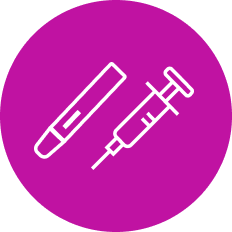
Strongly recommended by AAD and AAAAI guidelines as a systemic therapy for moderate-to-severe atopic dermatitis in adult patients1,2
Safety Results
The safety of Adbry was evaluated in an extensive clinical program3
Week 16 Safety
Demonstrated safety profile
Know the NOs of Adbry3
Long-Term Safety
Summary of safety up to 4.5 years4,5
- Safety profile over 4.5 years was consistent with initial treatment period4,5
- Discontinuation rates due to adverse events remained low4,5‡
*Pooled safety analysis set included patients from ECZTRA 1-3 and 5-8.
† Safety analysis set combining the parent trials with the subsequent ECZTEND trial including patients from first dose of Adbry until end of Adbry exposure or the ECZTEND data cut-off (April 30, 2022).
‡ Discontinuation rate was 5.3% (IR 2,7).
AE=adverse event; IR=incidence rate (n/100PYE); PYE=patient-years of exposure.
§ Up to 1 year in parent trials plus up to 5 years in ECZTEND.


